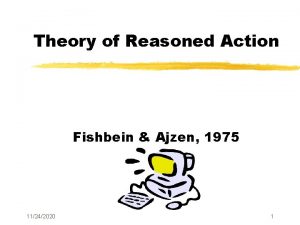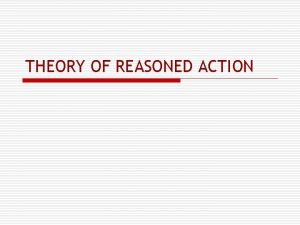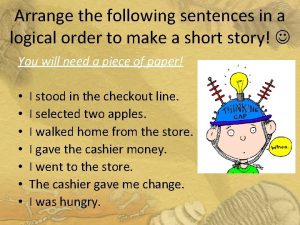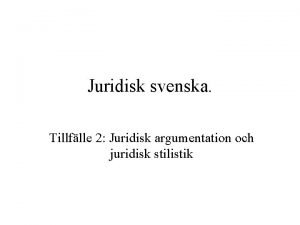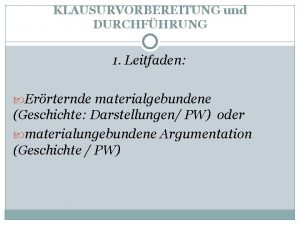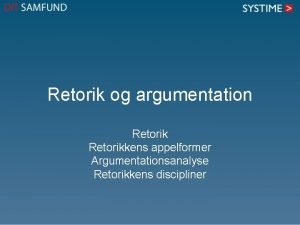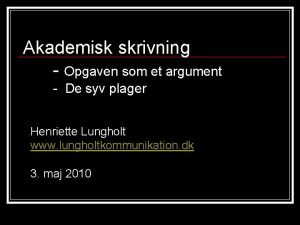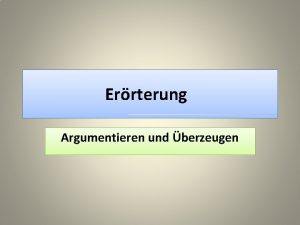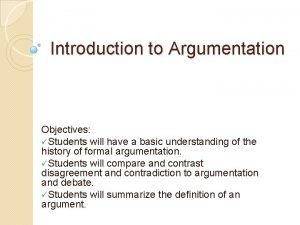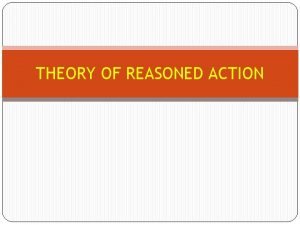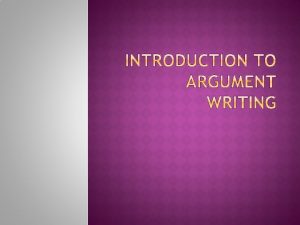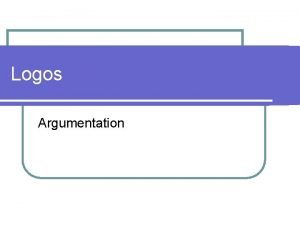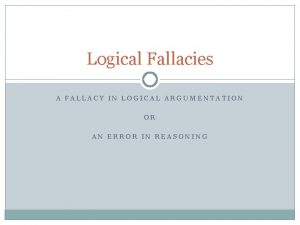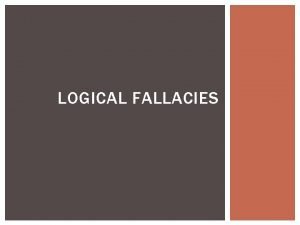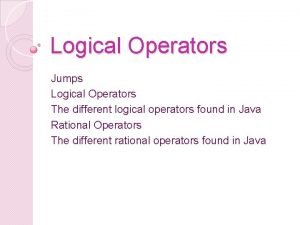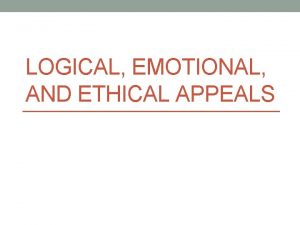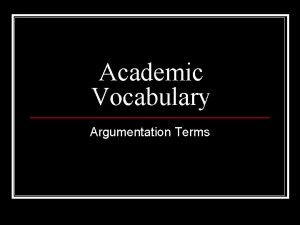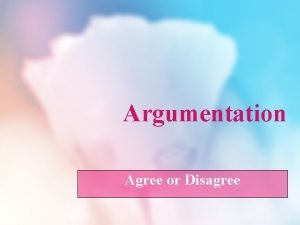Argumentation Argumentation is a reasoned logical way of
















- Slides: 16

Argumentation

• Argumentation is a reasoned, logical way of asserting the soundness of a position. • It is not persuasion. It is not opinionated. • Persuasion is the methods a writer uses to persuade an audience. • Persuasion is based on the writer’s manipulation of rhetoric (See notes about this!). • Argumentation is based on how logically and reasonably a writer presents facts. • In this unit, you will learn what makes an argument logical by analyzing arguments written by others and writing your own. • Your grad paper will also be argumentative. Basic Reminders

• Claim: Your central point, main idea, thesis—the thing you are trying to prove to be correct in your argument. • Evidence (or grounds): This is what supports your claim. Facts, data—in other words, evidence. Without evidence, your claim is groundless. It means nothing. • Connection (or warrants): The acknowledgement of the assumptions that underlie the argument. The warrant shows why the evidence connects to the claim. Remember this?

• This is my claim: Carol should be student body president. • My grounds/evidence: Carol is an honors student. • What is the assumption (or warrant) upon which those grounds support the claim? • Warrant: Honor students make good student body presidents. Example: Claim, grounds, warrant

Practice with claim, grounds, • Congratulations! warrant • Whether you know it or not, you’ve just participated in an activity that is thousands of years old. Claim: ? ? ? • You have used Evidence: El. Roy is very good at his job. deductive logic to Warrant: People who are good at their jobs get create raises. syllogistically sound arguments. Claim: Le. Roy should do well on his test. • (But you don’t actually have to Evidence: ? ? ? Warrant: People who study do well on their tests. know that. ) • Claim: Roy. Lee should be suspended. • Evidence: Roy. Lee cheated on his test. • Warrant: ? ? ? • • •

A statement that asserts the opposite of a position. • If you know that some people would support a possible antithesis, then you can be sure that your thesis is open to debate. Back to Carol, the counterargument is obviously that Carol should not be elected president. • Superior claims defeat that counterargument. We need to refute it. • Refutation: directly addressing counterarguments and proving that they are wrong. • So how would we refute the claim that Carol should not be president? Counterargument

• The rhetorical triangle represents the relationship between a speaker, the text and the audience. • Not much to define, but just in case. . . • Speaker: the person who delivers the text. • Text (or subject): the speech, poem, play, show, movie, book, essay, editorial, etc. • Audience: the intended audience for the text. Rhetorical Triangle

Rhetorical triangle

Plagiarism: Presenting the ideas of others as if they were your own. Is this plagiarism? 1. A recent study conducted at the University of North Carolina shows that “[n]early 60% of all high school students are guilty of plagiarism at one point in their high school education” (Curry 23). 2. According to leading educational research Arthur Curry, “Nearly 60% of all high school students are guilty of plagiarism at one point in their high school education” (23). 3. Plagiarism is a serious offense, one that 60% of high-schoolers have committed at one time or another. The final example is called a paraphrase. Despite the fact that it is originally worded, it is not an original idea; thus, it’s plagiarism.

Speaker and context: Atticus Finch in To Kill a Mockingbird. As you are reading. . . 1. 2. 3. 4. 5. Identify his claim. Identify grounds he uses to support his claim. Identify any warrant that connects the grounds to his claim (explicitly stated or assumed) Identify any counterargument that Atticus acknowledges and how Atticus refutes it. Identify examples of rhetoric. Analyze a Speech

Wall Crawl 1. You need one piece of paper. 2. You need 4 columns: Claim, Grounds, Warrant, Appeals. 3. You will analyze each ad for the items on your chart. ***Some ads might not provide any grounds! 4. You need to explain ALL of your answers!

• Come pick up an argument slip from Ms. Siciliano. Read the situation and audience on the slip. Keep it Secret! • Based on the situation and your audience, write an argument, at least 1 paragraph, which includes: • • • A claim Support for your claim Proof that your claim is valid Appeal to your audience (Ethos, Pathos, Logos) Announce counterargument (How will you prove it wrong? ) • Conclusion points and call to action (What should we do if you won? ) Lets Write an Argument

Ok, so you wrote an argument… • We will be dividing into groups. • Your groups all had the same scenario but a different audience…. so again, SECRET means do not announce it! • In your groups, try to figure out how your peers appealed to their audiences and, of course, who their audience is. • On your chart, evaluate whether or not your peers’ arguments were effective.

DUE Wednesday!!!! You will take one of the topics below and write an argumentative, typed, paragraph in MLA format utilizing the rhetoric skills you have learned to persuade your audience. • The topics you could choose from are: 1. Which platform is better: Apple or Android? 2. Which platform is better: Cable/Satellite or Streaming (Netflix/Hulu/etc. )? 3. Which platform is better: Instagram or Twitter?

1. Make a claim (This is where you stand on an issue. ) 2. Supply evidence to support your claim…data, facts, information (Explain why your evidence is valid. )! 3. Present a counterargument (what the other side is thinking!), and shut it down (prove them wrong!). 4. Acknowledge your audience so that it does not appear that you are attacking them, and have a call to action (what should we do if you win the argument? ). 5. You will need to underline where you use ethos, pathos, logos (You must use two of these rhetoric appeals!). Things that need to be in your argument…and some extra info!

You want to get a tattoo, but it is not well liked or allowed. How would you convince: • Your family • Your friends • Your artist (you’re underage) How does audience change your rhetoric?
 Fishbein ajzen 1975
Fishbein ajzen 1975 Reasoned action theory adalah
Reasoned action theory adalah Theory of reasoned action adalah
Theory of reasoned action adalah Kesetaraan logis
Kesetaraan logis Logical form and logical equivalence
Logical form and logical equivalence Arrange the following sentence
Arrange the following sentence Stilistisk term
Stilistisk term Weimarer republik zum scheitern verurteilt pro contra
Weimarer republik zum scheitern verurteilt pro contra Argumentationsanalyse eksempel
Argumentationsanalyse eksempel Argumentation
Argumentation Forvægt og bagvægt
Forvægt og bagvægt These
These Introduction to argumentation
Introduction to argumentation Types of argumentation
Types of argumentation Argumentation
Argumentation Tierversuche argumentation
Tierversuche argumentation Argumentation gliederung
Argumentation gliederung
